-

人教版新目标初中英语九年级上册It must belong to Carla教案
一、Section A该部分有4个模块。第一模块围绕Whose volleyball is this? 这一话题展开思维( 1a)、听力(1b)、口语( 1c)训练;第二模块围绕上一模块中的话题进行听力( 2a-2b)、口语训练( 2c);第三模块继续围绕前两个模块中的“making inferences”展开训练。训练形式为阅读排序( 3a)和两人问答(3b);第四模块仍就上一话题展开讨论。二、Section B该部分有4个模块。第一模块要求根据图画和所提供的单词写出合理的句子;第二模块在听力( 2a-2b)和分角色口语训练( 2c)的基础上,继续进行“推测”训练; 第三模块围绕“Strange events in Bell Tower neighborhood”这一话题展开阅读( 3a)和写作(3b -3c)训练;第四模块以dream为话题展开小组活动。三、Self Check该部分有3个模块。第一模块以填空形式对所学词汇进行训练;第二模块就8个谚语展开阅读和讨论。

人教版新目标初中英语七年级上册Do you have a soccer ball教案
在这一单元中,学生要学会就有关人与物之间所属关系进行问答的句子。本单元大量引入有关运动的名词,要求学生彼此询问有无此类物品,并做出相应的回答。 同时学习表示建议的句型Let’s运动的形容词。 本单元所选用的话题来自学生所喜欢的生活片段,在教学中生生交流、师生交流会更融洽,会促进师生彼此间的了解,成功的教学还会让部分学生养成良好的运动习惯和收藏习惯。 教学目标 1) 语言知识:A.在询问对方是否有某物的对话中学会使用do和does引导的一般疑问句; B. 学会使用描述性的形容词来评价事物; C. 学会在对话中使用名词复数; D. 学会用祈使句来向对方提出建议. 2) 语言技能:A. 学会用祈使句询问某人是否有某物; B. 学会向他人提出建议的句子. 3) 学习策略:A.通过与同学讨论,做出猜测;

人教版新目标初中英语七年级上册Do you want to go to a movie教案
讨论喜欢的影视类型及理由:在看过一部影视作品后,大家总是喜欢在一起谈论影视的主要内容、主要情节、主要演员主题歌曲、主题音乐等,互相介绍自己对该影视的看法。教师可以组织一次活动,分组讨论学生喜欢看什么类型的电影,并说明喜欢的理由。运用I like…I don’t like…Because it is…等语言结构;然后每个组选派一名代表向全班学生阐述本组组员喜欢观看的电影类型;最后汇总,总结出全班同学最喜欢观看哪一种类型的电影。如果有可能,根据学生的选择放一部(一段)这种类型的影视节目。通过学生的讨论、调查,使他们在完成任务的过程中学会询问和陈述自己或别人在影视方面的喜好及理由,更好地巩固所学内容。Self Check教学内容Self Check(教材P58)教学目标知识与能力复习词汇go,movie,action,comedy,documentary,thriller,and,but,scary,funny, sad,exciting;引导学生复习、巩固“制订计划和打算并谈论喜好和偏爱”的目标语言。

人教版新目标初中英语七年级上册My favorite subject is science教案
本单元主要学习一周中星期一到星期天的表达方式;掌握学科的表达;学习用because和表示品质的形容词表示理由;学习what,why,who引导的特殊疑问句。本单元围绕“谈论自己所喜欢的学科”这一话题,设计了三个任务型活动:任务一是:谈论自己所喜欢的学科,学习what引导的特殊疑问句和学科的表达;任务二是:一分钟演讲,让学生介绍自己喜欢某一学科的理由,学习why等特殊疑问句;任务三是:写信,巩固和延伸所学知识,掌握星期的表达方式。单元知识系统(树)What’s your/his/her favorite subject? My/His/Her favorite subject is English.Why do you like math. Because it’s interesting.Why does he/she like art? Because it’s fun.When do you have math? I have math 0n Monday,Wednesday and Friday.What’s Ken’s favorite subject? Science.单元总体目标通过本单元的学习使学生学会谈论自己喜好的学科或自己喜好的其它事情并给出理由;学会说出一周的七天;学会合理地安排自己的作息时间。

人教版新目标初中英语七年级下册I ’d like some noodles教案
教学过程Step 1: warming-up Sing a song---------“food and drink” Step 2: Revision1 Dictation2 Revise: What kind of noodles would you like?I’d like …What size bowl of noodles would you like?I’d like…Step 3: Presentation1 show pictures of food, ask students say the words.2 Students read the newspaper ad in 3a. Fill in blanks with words in the box. Then read the ad together, the teacher explains some difficult language points.3 Check the answers Step 4 PracticeAsk students to finish 3b in the same way according to 3a. Students read the short passage and fill in the blanks .At last, check the answers.Step 5 productionAsk students to write their own ad for dumplings, noodles, drinks, and other foods they know. Then ask students to read their partner’s ad. Then order food and drink from their partner.Step 6 Home workGroup work – make an ad about “food and drink”

人教版新目标初中英语七年级下册What do you think of game shows教案
五、教学Section B-2c1. Pair work: What do you think of the belt/sunglasses/…? What does your father/mother/… think of your scarf/belt…?2. Group work(1). Teacher shows some different kinds of school uniforms (制服)and asks : “ What do you think of your school uniforms? If you have a chance to choose your school uniforms, what kind would you like to choose?”(2). Discuss in groups.(3).Get some Ss to report in class.说明:这一步旨在让学生运用已有的语言知识谈论对事物的看法和意见,并简单阐明理由,培养学生的主动思维能力和运用英语的能力。六、教学拓展调查电视节目的收视率任务:调查你周围的人对现在各种电视节目的反响。活动过程:1.教师布置任务,让学生调查周围的人(包括他的亲戚朋友和邻居)喜欢收看哪方面的电视节目。2.学生进行调查活动,运用本单元所学的句型What do you think of….? (Why?)What's your favorite game shows?What do you think of talk show?I doesn’t mind it.I like it.I love it.I can’t stand it.3.记录下排在前10位的TV Program,填写调查表,比较其收视率。

人教版新目标初中英语九年级上册I like music that I can dance to教案
教学目标: 1. Express preferences2. Talk about one’s likes and dislikes and the reasons3. Learn to express one’s opinions 4. Learn to write a reply 语言功能: 1) Talk about one’s preferences, using t he relative clause2) Talk about people’s likes and dislikes and the reasons3) Talk about opinions语言结构: Relative clauses with that and who语言目标:What kind of music do you like?I like music that I can sing along with.I love singers who write their own music.We prefer music that has great lyric.重点词汇及短语:heart, photography, interest, class, whatever, miss, okay, expect, sweet, taste, itself, laboratory, cancer, increase, biscuit, main, care, prefer… to…, remind somebody of …, dance to, sing along with, be sure to, interest somebody, make somebody adj., to be honest, suit somebody, on display, catch up教学重难点:What do other people think of the different kinds of things? How to express one’s opinions? 学习方式:讨论,合作学习情感目标:通过本单元的学习,能提高学生的艺术鉴赏能力和审美情趣,并引导学生养成健康的饮食习惯。课时安排5课时第一课时:Section A: 1a-2c第二课时:Section A : 3a-4第三课时:Section B:1-2c, Self check2第四课时:Section B: 3a-4, Self check1第五课时:Self check ReadingI like music that I can dance to.

人教版新目标初中英语九年级下册By the time I got outside, the bus had already left教案
Ⅰ. Teaching Aims and Demands1. Knowledge Objects(1) Key Vocabularyoversleep(2) Target LanguageWhat happened?I overslept. And by the time I got up, my brother had already gotten in the shower.2. Ability Objects(1) Teach the students to use the new words.(2) Train the students to narrate past events with the Past Perfect Tense.(3) Train the students' listening and speaking skills with the target language.3. Moral ObjectIt’s a good habit to go to bed early in the evening and get up early in the morning. So you’ll never be in a hurry in the morning.Ⅱ. Teaching Key Points1. Key Vocabularyoversleep2. Target LanguageNarrate past events with the Past Perfect TenseⅢ. Teaching Difficult Points1. Train the students to narrate past events with the Past Perfect Tense.2. Train the students to understand the target language in spoken conversation.Ⅳ. Teaching Methods1. Thinking of examples from the students' real lives.2. Making sentences by looking at the pictures.Ⅴ. Teaching AidA tape recorderⅥ. Teaching ProceduresStep I Revision1. Revise the language points in Unit 8.Ask some questions like this: What volunteer work would you like to do?Help the students to answer, I’d like to…/I love to…/I hope to2. Practice the dialogue in Activity 3c on page 62 again. Get students to role play the similar dialogues with the following.

人教版新目标初中英语九年级下册Rainy days make me sad教案
1. 教材分析本单元以how do things affect you?为话题, 从颜色、天气、音乐、广告、产品等方面谈论了外界事物如何影响人的心情。要求学生掌握表达某物或某事给人带来的感觉、看法或影响等。共设计了四个部分的内容:Section A 该部分有4个模块:第一模块围绕Which restaurant would you like to go to?这一话题展开思维(1a)、听力(1b)、口语(1c)训练;第二模块围绕How does music affect you? 进行听力(2a-2b)、口语训练(2c);第三模块继续围绕how do colors in the restaurant affect you这一话题展开训练,训练形式为阅读和问题体验(3a)和小组活动(3b);第四模块仍就How do things affect you这一话题以调查的形式展开讨论。Section B该部分有4个模块:第一模块围绕产品广告对人们的影响这一话题以“配对”(1a)与“列举”(1b)两种形式展开训练;第二模块继续围绕How do things affect you? 进行听力(2a-2b)、口语对话训练(2c);第三模块围绕“Advertising”这一话题展开阅读(3a-3b)和写作(3c)训练;第四模块围绕How posters affect you这一话题以口语训练形式展开小组活动。

人教版新目标初中英语九年级下册Could you please tell me where the restrooms are教案
Step Ⅰ RevisionCheck homework. Ask a few students to read the article in 3a.Then ask a few students to read their guides.Step Ⅱ Part 1Look at the words in the box. Ask a student to read them. Make sure the students understand the meaning of the words. You are to fill in the blanks with the words. In some cases, students may need to use another form of the word, for example adjusting for tense or subject/ verb agreement.Ask students to fill in the blanks on their own.Check the answers. Step ⅢPart 2Go through the instructions with the class.Look at the example with the students.Ask students what the answer would be.Ask a student to read the question and answer it.Excuse me, could you tell me where the bank is, please?The bank is across the street from the shopping malt.Get students to complete the work in pairs.Check the answers. Ask a few students to read their questions.Step Ⅳ Just for Fun!Ask all the students to read the conversation. Ask: What is funny about this cartoon? Help students to explain. A Martian is a person from the planet Mars.There is no such thing as Martian food on Earth, and the clerk looks silly because he is trying to think of where there is a Martian restaurant.Invite some pairs of students to present this conversation to the rest of the class.Step Ⅴ Summary and HomeworkIn this class, we’ve done much writing practice using the key vocabulary words and the target language presented in this unit. After class, please finish the questions in 2 in your exercise books. Then finish the exercises on pages 47~48 of the workbook as well.The Seventh Period Ⅰ Teaching Aims and Demands1. Knowledge Objects(1) Key Vocabularyimage, adventure, jealousy, hero, crime, journey, brave, no longer, show interest in, take it easy, become interested in, plain looks(2)Text:Grown-ups like cartoons, too.2. Ability Objects(1) Fast-reading to get a general idea of the text.(2) Careful-reading to get the detailed information in the text.

人教版新目标初中英语九年级下册I’ll help clean up the city parks教案
Talk about offering help (P60)I’ll help clean up the city parks.A: I’d like to work ...B: You could help ...Talk about ways to tell people about the Clean-Up Day (P61)We need to ...We can’t ...I’ll ...Talk about the work the volunteers do (P62)These three students all volunteer their time to help other people.Somebody loves to ... / helps ... / plans to ... / wants to ...A: What do you like doing?B: I like ... A: What kind of volunteer work do you think I could do?B: You could ...1. 重点词汇advertisement, fix, repair, pleasure, blind, deaf, shut, carry, specially, fetch2. 认读词汇hunger, homeless, cheer, clean-up, sign, establish, major, commitment, elementary, veterinarian, coach, similar, call-in, strategy, disabled, organization, unable, support, appreciate, donation, part of speech, pronoun, adverb, preposition, conjunction, donate, Jimmy, Sally3. 词组clean up, cheer up, give out, put off, set up, think up, take after, fix up, give away, put up, hand out, work out, at once

人教版新目标初中英语九年级下册You’re supposed to shake hands教案
教学目标:1. 掌握本单元一些重点词汇的写法和用法。2. 学会自如谈论餐桌礼仪。Step 1 RevisionAsk some students to retell the customs at the table in France in the passage in 3a.Step 2 Self checkPart 1. Fill in each bland with the correct word given. Students do the exercises by themselves at first. Then check the answers. Ask the students to comprehend the sentences and help them point out uses of some words, like “arrive (at / in) sw., spend time / money on sth , spend time / money (in) doing sth.”Part 2. Read about Fan Ling’s experience in a western restaurant. Understand the passage. Point out some key points in the passage.1. be / get used to doing sth. 习惯做某事2. begin with = start with 以….开头3. crowd v. 挤满,塞满 the crowd 人群 crowded adj. 拥挤的Then students discuss about how she would solve her problem. Ask some to share their stories with others.Part 3. Complete the crossword by looking at the sentences on the left. Then check the answers.
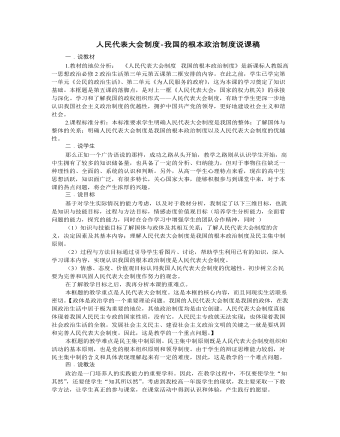
人教版高中政治必修2人民代表大会制度-我国的根本政治制度说课稿
材料四:两会结束后,全国人大常委会办公厅将召开代表建议交办会,将这些建议统一交由国务院有关部委、最高人民法院、最高人民检察院等180个机关、单位办理。】通过分组讨论,请学生回答问题,我将做相应的点拨和补充:在人民代表大会与人民的关系上,从产生看,人民代表大会的代表由民主选举产生,对人民负责,受人民监督;从过程看,在人民代表大会的活动中,法律的制定和重大问题的决策,由人民代表充分讨论,实行少数服从多数原则,民主决定;在人民代表大会与其他国家机关的关系上,人大是国家权力机关,国家行政机关、审判机关、检察机关都由它产生,对它负责,受它监督。人大统一行使国家权力,它所决定的事情不是自己直接去办,是由国家行政和司法等机关去贯彻执行。请同学们根据刚所学的知识,将民主集中制原则的具体体现,用表格形式进行归纳总结,培养了学生归纳分析能了和独立思考的能力。
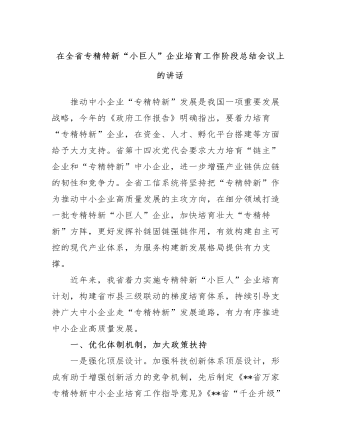
在全省专精特新“小巨人”企业培育工作阶段总结会议上的讲话
在全省“专精特新”中小企业普及推广两化融合管理体系升级版标准,系统推进数字化转型,加快落地实施形成数字化管理的典型案例。在细分行业打造一批智能化生产、网络化协同、个性化定制、服务化延伸等业态模式创新典型的工业互联网标杆企业,引导“专精特新”中小企业依托工业互联网平台,综合运用数据采集与集成应用等技术,实现生产制造以及产品、工厂资产和商业的全流程优化。聚焦“专精特新”中小企业关键需求,推动建设一批智能制造服务平台,为“专精特新”中小企业提供专业化服务,加快信息技术集成应用,增强装备的可接入水平和装备间数据交互能力,支持“专精特新”中小企业建设智能车间。支持面向行业的工业互联网平台建设,大力推广网络协同制造、共享制造等新模式,支持“专精特新”中小企业开展智能制造能力成熟度评估,引导企业因地制宜开展智能制造,不断提升精益生产、精细管理和智能决策水平。

不玩火安全教案
二、活动准备1.《安全防火》课件ppt2.火灾相关的'图片3.消防模型或玩具4.逃生演练时需要的毛巾、电话5.几种防火安全标志。三、活动重难点1.重点是引导幼儿知道要防火,火灾到来的危险性和后果性。2.难点是自救,如何在大火来临时自我保护和自我逃生。
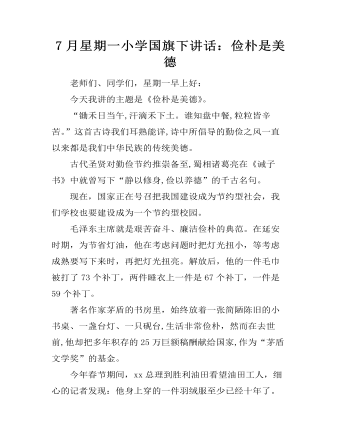
7月星期一小学国旗下讲话:俭朴是美德
老师们、同学们,星期一早上好:今天我讲的主题是《俭朴是美德》。“锄禾日当午,汗滴禾下土。谁知盘中餐,粒粒皆辛苦。”这首古诗我们耳熟能详,诗中所倡导的勤俭之风一直以来都是我们中华民族的传统美德。古代圣贤对勤俭节约推崇备至,蜀相诸葛亮在《诫子书》中就曾写下“静以修身,俭以养德”的千古名句。现在,国家正在号召把我国建设成为节约型社会,我们学校也要建设成为一个节约型校园。毛泽东主席就是艰苦奋斗、廉洁俭朴的典范。在延安时期,为节省灯油,他在考虑问题时把灯光扭小,等考虑成熟要写下来时,再把灯光扭亮。解放后,他的一件毛巾被打了73个补丁,两件睡衣上一件是67个补丁,一件是59个补丁。著名作家茅盾的书房里,始终放着一张简陋陈旧的小书桌、一盏台灯、一只砚台,生活非常俭朴,然而在去世前,他却把多年积存的25万巨额稿酬献给国家,作为“茅盾文学奖”的基金。今年春节期间,xx总理到胜利油田看望油田工人,细心的记者发现:他身上穿的一件羽绒服至少已经十年了。
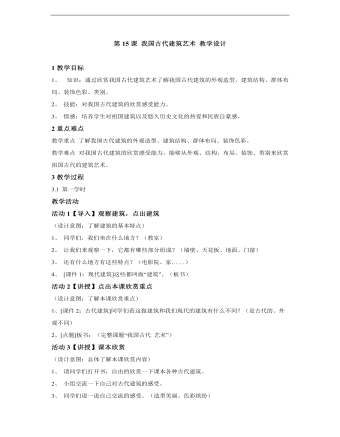
小学美术人教版六年级下册《第15课我国古代建筑艺术》教学设计说课稿
2重点难点教学重点了解我国古代建筑的外观造型、建筑结构、群体布局、装饰色彩。教学难点对我国古代建筑的欣赏感受能力,能够从外观、结构、布局、装饰、类别来欣赏祖国古代的建筑艺术。3教学过程3.1 第一学时教学活动活动1【导入】观察建筑,点出建筑(设计意图:了解建筑的基本特点)1、同学们,我们坐在什么地方?(教室)2、让我们来观察一下,它都有哪些部分组成?(墙壁、天花板、地面、门窗)3、还有什么地方有这些特点?(电影院、家… …)4、 [课件1:现代建筑]这些都叫做“建筑”。(板书)
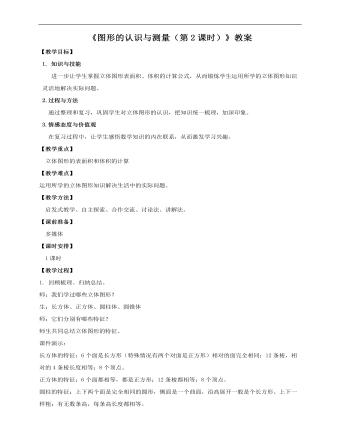
小学数学人教版六年级下册《第五课图形的认识与测量(第2课时)》教案说课稿
【课时安排】 1课时【教学过程】1.回顾梳理、归纳总结。师:我们学过哪些立体图形?生:长方体、正方体、圆柱体、圆锥体师:它们分别有哪些特征?师生共同总结立体图形的特征。 课件演示:长方体的特征:6个面是长方形(特殊情况有两个对面是正方形)相对的面完全相同;12条棱,相对的4条棱长度相等;8个顶点。正方体的特征:6个面都相等,都是正方形;12条棱都相等;8个顶点。圆柱的特征:上下两个面是完全相同的圆形,侧面是一个曲面,沿高展开一般是个长方形。上下一样粗;有无数条高,每条高长度都相等。
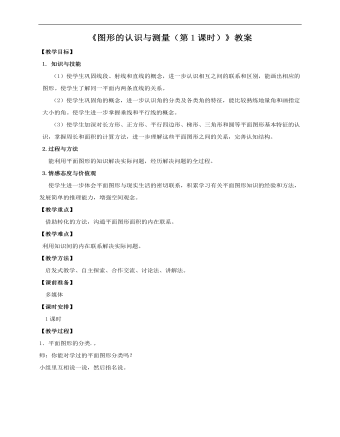
小学数学人教版六年级下册《第五课图形的认识与测量(第1课时)》教案说课稿
2.三角形的分类。师:你能给三角形按照不同的标准进行分类吗?生用自己喜欢的方式整理分类,然后汇报:生:三角形按角分为锐角三角形、直角三角形、钝角三角形。师:什么是锐角三角形、直角三角形、钝角三角形?生:三个角都是锐角的三角形叫做锐角三角形;有一个角是直角的三角形叫做直角三角形;有一个角是钝角的三角形叫做钝角三角形。生:三角形按边分为不等边三角形(三条边都不相等)、等腰三角形(等边三角形) 等腰三角形的两条边相等,等边三角形的三条边都相等。3.四边形分类。师:你能给四边形分类吗?生:四边形分为平行四边形和梯形;平行四边形包括长方形和正方形,长方形又包括正方形;梯形包括等腰梯形和直角梯形。4.直线、射线和线段的关系。小组内互相交流,然后汇报:
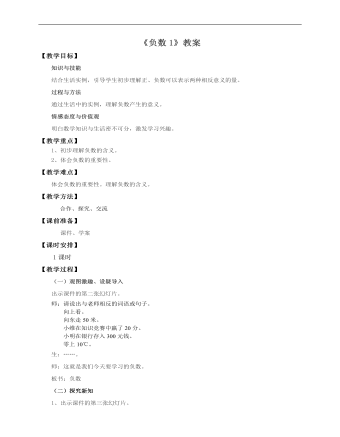
小学数学人教版六年级下册《第一单元第一课负数例1例2》教案说课稿
(一)观图激趣、设疑导入 出示课件的第二张幻灯片。师:请说出与老师相反的词语或句子。向上看。向东走50米。小维在知识竞赛中赢了20分。小明在银行存入300元钱。零上10℃。生:……。师:这就是我们今天要学习的负数。板书:负数(二)探究新知1、出示课件的第三张幻灯片。师:请大家仔细观察上图,你发现什么问题?学生以小组为单位交流。学生以小组为单位汇报交流结果。生:0℃表示什么意思呢?生:3℃和-3℃表示的意思一样吗?师:小组内交流解决上述问题。学生以小组为单位探究交流。学生以小组为单位汇报探究交流结果。老师对学生汇报给予适当的评价。老师课件出示答案。师:0℃表示淡水结冰的温度,比0℃低的温度叫零下温度,通常在数字前加“-”(负号),如-3 ℃表示零下3摄氏度,读作负三摄氏度;比0℃高的温度叫零上温度,在数字前加“+”(正号),一般情况下可省略不写:如+3℃表示零上三摄氏度,读作正三摄氏度,也可以写成3℃,读作三摄氏度。


